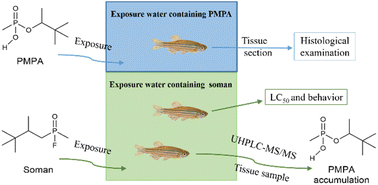Toxic effects and bioaccumulation of pinacolyl methylphosphonate acid in zebrafish following soman exposure to a water environment†
Abstract
Soman has been shown to be highly neurotoxic and can be easily degraded to produce pinacolyl methylphosphonate acid (PMPA). Thus, the perniciousness of PMPA deserved serious attention after soman was exposed to the environment. However, the toxicity of PMPA was not clearly elucidated to date. In this regard, the objective of this study was to determine if PMPA could pose an environmental risk after soman exposure to a water environment. In this study, the toxicity and bioaccumulation assessments of PMPA were carried out on zebrafish. Histological examination was used to assess the toxicity of PMPA in zebrafish and revealed that PMPA has chronic toxicity in view of tissue injury. The contents of PMPA in whole zebrafish and tissues were determined after soman exposure. The result showed that PMPA bioaccumulated in the whole zebrafish and tissue, especially the liver and intestinal tissues. This is the first report showing that the hydrolyzate of a G-series chemical nerve agent could accumulate in organisms. This study offers novel insights into the environmental risk assessments associated with soman exposure to a water environment.



 Please wait while we load your content...
Please wait while we load your content...